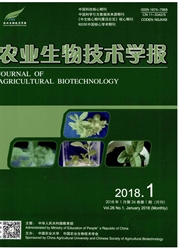

 中文摘要:
中文摘要:
TILLING(targeting induced local lesions in genomes)技术作为反向遗传学的一个重要研究工具,其中CEL(celery)Ⅰ酶是TILLING技术的核心内切酶。实验通过硫酸铵沉淀、亲和层析、阴阳离子交换柱层析等常规的蛋白质纯化过程,从芹菜(Apium graveolens)中粗纯化了CELⅠ酶。以杂合双链DNA为底物,检测了CELⅠ酶在不同纯化程度、不同温度、不同处理时间以及有无TaqDNA聚合酶条件下的错配切割活性。结果表明,所获得的CELⅠ酶得到了粗纯化;CELⅠ酶的最适活性温度范围为45~50℃;处理时间长达150min时,CELⅠ酶仍能特异识别并切割错配碱基;在含有TaqDNA聚合酶的酶切体系中,CELⅠ酶错配切割效果更佳。与其它单位提供的CELⅠ酶活性相比,实验粗分离纯化的CELⅠ酶的酶切条带更亮,说明其活性更好。通过对CELⅠ酶的提取及活性分析,为TILLING技术大规模和低成本地应用于家蚕功能基因组研究提供了保障。
 英文摘要:
英文摘要:
Targeting induced local lesions in genomes (TILLING), as an important research technology in reverse genetics has been widely applied in many model organisms. CEL (celery) Ⅰ enzyme from celery (Apium graveolens) is a key enzyme in TILLING technology. The endonuclease CEL Ⅰ with high activity from celery was crudely purified by (NI-L)2SO4 deposition, affinity chromatography, anion and cation chromatography. Using heteroduplex DNAs as the substrates, the various activities of CELⅠ were further investigated under the various combinations of different purified levels, digestion temperatures, treatment time and presence or absence of Taq DNA polymerase. The results indicated that the CELⅠ was crudely purified, the optimum temperatures were between 40 to 50 ℃, special digestion for mismatch bases was well in 150 min, and the activity ofCEL Ⅰ would be higher when Taq DNA polymerase was present in the reaction system. The activity value of CELⅠ purified in this experiment was a little higher than that from other institutions. The results will provide technology supports for application of TILLING with large scale and low cost in silkworm.
 同期刊论文项目
同期刊论文项目
 同项目期刊论文
同项目期刊论文
 期刊信息
期刊信息
